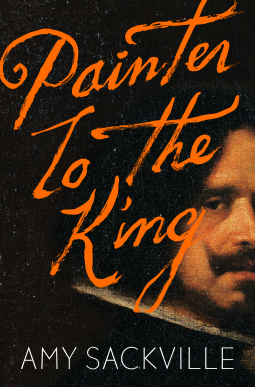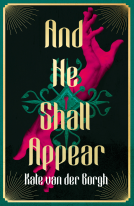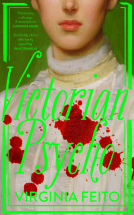
Painter to the King
by Amy Sackville
This title was previously available on NetGalley and is now archived.
Send NetGalley books directly to your Kindle or Kindle app
1
To read on a Kindle or Kindle app, please add kindle@netgalley.com as an approved email address to receive files in your Amazon account. Click here for step-by-step instructions.
2
Also find your Kindle email address within your Amazon account, and enter it here.
Pub Date 5 Apr 2018 | Archive Date 1 Apr 2018
Granta Publications | Granta Books
Talking about this book? Use #PainterToTheKing #NetGalley. More hashtag tips!
Description
The new novel from Amy Sackville -- a story of imagination and intrigue about the painter Velazquez and his royal subject and benefactor, King Philip IV of Spain.
This is a portrait of Diego Velázquez, from his arrival at the court of King Philip IV of Spain, to his death 38 years and scores of paintings later. It is a portrait of a relationship that is not quite a friendship, between an artist and his subject. It is a portrait of a ruler, always on duty, and increasingly burdened by a life of public expectation and repeated private grief. And it is a portrait of a court collapsing under the weight of its own excess.
Unfolding through series of masterly set-pieces and glancing sketches, this is a novel of brilliance, imagination and sheer style -- about what is shown and what is seen, about art and life.
Advance Praise
'For some years now, Amy Sackville has been known for the exquisite quality of her prose. With her third novel, she has tried something different, something more audacious, perhaps, and proves more than equal to the challenge. A work of great subtlety and sophistication, Painter to the King is a surprisingly tender portrait of a genius'
Rupert Thomson
Available Editions
| EDITION | Hardcover |
| ISBN | 9781783783908 |
| PRICE | £16.99 (GBP) |
Average rating from 12 members
Featured Reviews
 Joseph C, Reviewer
Joseph C, Reviewer
Every so often, a novel comes along that challenges one’s expectations of the genre. Amy Sackville’s Painter to the King is one such work. It is, ostensibly, a fictional biography of Diego Velázquez, covering in particular the decades he spent in the service of King Philip IV of Spain and the relationship which developed between the artist and the monarch who was his royal/loyal patron. Sackville is surprisingly faithful to the ‘facts’, even down to what may seem trivial historical details. Yet, her novel is by no means a straightforward retelling of the life of Velázquez. For a start, she adopts a sort of stream of consciousness narration – which is often breathless and febrile, on occasion seemingly tentative or improvisatory. It feels as if we have stepped into a painting which is taking shape or as if we’re standing behind the painter, watching as he sketches at his easel. This impression is strengthened by the very ‘visual’ descriptions, full of colour and movement and the play of light and dark. Indeed, the chapters often have the atmosphere of a tableau, a scene ready to be set down for posterity.
At intervals, the third person approach is interrupted by the narrator intruding with her own ruminations. One should always be wary of identifying the author with the novel’s subject, but it is difficult not to see Sackville herself in the thirty-something narrator embarking on a literary pilgrimage on the steps of Velázquez. It is an inspired touch gives the novel a personal meaning and reveals that it is a labour of love. At the same time, however, it can be taken as a warning that, despite all endeavours at authenticity, it is difficult, if not impossible, to recreate the past and particularly the thoughts and feelings of historical figures. This novel is, indeed, biographical and historical but is equally a very contemporary ‘imagining’ of the past.
And this brings us to the heart of what is, ultimately, a highly philosophical novel. I felt Painter to the King to be an exploration of the correlation between art and artifice, truth and reality, public personas and private feelings. The characters the novel are constantly preoccupied as to what will survive after their death – the King’s obsession with having his portraits painting is a way of ensuring his memory remains. But even though Diego is notorious for his devastating honesty and his inability to “lie” in his portraits, can we be sure that the King we know is not shaped by the painter’s imagination, just as Diego and his monarch speak to us through Sackville’s prose?
I found this to be a challenging novel, one which I read over a number of weeks alongside less demanding fare. But it is an impressive achievement and I would be surprised and disappointed if this is not – deservedly – recognised when the time for literary awards arrives.
 Lee P, Educator
Lee P, Educator
This is a challenging but rewarding look at the life of Spanish painter diego velazquez. Much of the prose here feels like Amy Sackville is painting with words. While the artist she discusses is known for realistic creations this book is very much the opposite of that. Here we have beautiful images created through words that somehow weave together a story framed by a narrator looking back on the life of an artist through his own works. If that sounds a little unusual, it's because this book is just that. Unusual, odd, challenging, rewarding, poignant, modern yet classical.
This book resists obvious classification. I am not sure exactly who I could recommend this to. However, I would have doubted my own enjoyment of this book given that I had never heard of the artist, had never seen his works and I have little interest in the historical period covered. And yet, I still really enjoyed it. So, if you're in the market for something a little different, I guess I would advise giving this a go.
'Here you almost are'
An unusual novel that attempts to articulate a man, an artist and his works in words. Framed through a narrator imaginatively entering into a painting, this is a paradoxically impressionistic work, given that Velazquez's own works were more concerned with the physical materialism of court, world and personality.
Looking obliquely at the courtly world of seventeenth century Spain, the rituals, the patronage, the incessant concern with creating the right image of power, monarchy and authority, this foregrounds the struggle of an artist to be viewed as a poet of paint, rather than mere artisan.
Oddly propulsive, moving from ecphrasis to fragments of live, this is a postmodern attempt to capture visual art in words.
 Angela C, Reviewer
Angela C, Reviewer
This is a story within a story where the paintings of Velazquez are the bridge between the past and present. It took me a little time to get into because of the writing style but overall is a beautiful book which is poetic and strongly visual. Amy paints vignettes with words and I found myself recalling parts of it after I finished.
I particularly liked the details of the King’s court during Velazquez’s time there. For example there is an actress, La Calderona who the King takes a fancy to. The king gives her a palace where she resides as “a queen of half lit shadows” and then languishes, seemingly neglected, eventually sent off to a nunnery. There is the building of a grand palace and paintings, so many paintings for the royal painter to carry out. There are deaths too – at one point, there are even fears for the King as “Death sighs her lungless sigh”. It is the deaths of Royal children that have a poignancy which seemingly taints the King’s later years as he worries over heirs.
Amy somehow manages to draw out the passages of time in this novel and when we are suddenly thrown into the present day where we have someone wondering about Velazquez as they contemplate his paintings and visit the places he inhabited and knew, I felt I was part of the novel.
A beautiful book to take the time to read.
 Philipa C, Reviewer
Philipa C, Reviewer
An intriguing approach to the narrative and learning something new in history are aspects of this novel that appealed to me.
Philip IV lived from 1605-1665 but his reign oversaw a decline in Spanish power. He was very interested in the arts and the need for a Court painter brought forward Diego Velzquez, "A new artist has been sent for" and portraits were required of the young King, his spouse and family (when the children managed to survive).
The author writes with delicate intimacy of the life of the Spanish court and although descriptions can seem long winded they are well researched and give valuable information about the small matters - food eaten, daily bathing and the role of those who surrounded the King. Velzquez came from Seville to the court in Madrid and was a student and follower of Rubens with whom he had travelled and studied in Italy - the Renaissance style much influencing his work. There are descriptions of the painter's wife Juana and their daughter and the presence of Juana's father who had also been influential in promoting Velzquez to his prominence in the Spanish art world at the time.
The narrator is a third person, often seen as a contemporary tourist revealing the streets in which you can follow the painter's life - the Calle concepcion Jeronima where a yellow plaque indicates where the painter once lived.
If you have read Tracy Chevalier's 'The Girl with the Pearl Earring' this takes a different approach. A more intimate world as we follow the painter gaining the confidence of the King and the Court, especially those such as the prime Minister Count Olivares who had called Velzquez to Madrid first in 1623 and later in 1651 to complete the historic pictorial reproductions of the King.
Readers may be familiar with the famous painting Las Meninas in which there is a self portrait of the painter and reflections of Hilip IV and Queen Mariana with their daughter (the Infanta) Margarita and her maids taking centre stage. It was painted in 1656 as the painter's fame grew and is now on display at the Prado in Madrid.
A literary and historical triumph for readers to delve into the intimacies of a monarchy and the place of art in a world where wealth, marriage and winning wars and gaining territory were still priorities..
 Ali T, Reviewer
Ali T, Reviewer
A compelling portrait of the long professional relationship between the painter, Diego Velazquez and his master, the 17th century King of Spain, Philip IV.
Amy Sackville uses the paintings themselves to create a vivid evocation of a dark, claustrophobic court where power is concentrated on the person of the king. As a young man, Velazquez is summoned to the court and (apart from a few visits home to Seville or to Italy) for the rest of his life there he stays, painting portraits of the king and members of his family.
In times of peace and war, and in the face of personal bereavement, Philip must be seen as a king who makes his confession to god and although 'melancholy by temperament' he must be 'A Planet King, a golden king to warm and shine upon this golden age'. We see the extravagance of the court but we also see the precarious nature of favour - the use and abuse of power; who's in and who's out. 'Inside their black clothes in the dark, [the courtiers] sweat like animals'. The overriding requirement is for Philip to provide an heir (male) but this proves to be difficult; and over decades, as he ages and loses members of his family, the king gradually becomes increasingly world-weary. All of this is recorded by Velazquez' paintbrush.
At a time of primitive medical knowledge, with the ever-present shadow of death waiting in the background, we see the fragility of life. A lot of people die in this novel, whether it's children taken by a fever, women dying in childbirth or people simply succumbing to one of the many illnesses that were untreatable at the time. The brooding sense of imprisonment creeps into Sackville's own sense of life passing, of the skull under the skin.
The story is told through the eyes of both painter and king, but what makes this intriguing novel even more nuanced is that throughout the work the author places herself in the narrative, as in the work of W G Sebald. In the present day we see Sackville travelling in Spain, researching the period, following in Velazquez's footsteps and searching for traces of his life beyond that of his paintings.
'None of these things, these solid objects on an outdoor table at the centre of this plaza in Madrid this evening, now seem as solid as that glossy red onion that rotted almost four hundred years ago'.
Sackville's language is lyrical and poetic, rich and minutely observed. She describes a feast:
'... the larded lamb, the tongues of oxen mute and resting heavy on their silver plates; and the costly scents of spices, of saffron, of chocolate, shipped from the Americas... the almond confections and sticky honeyed fruit and cakes...'
What is so striking about this novel is the link between the observer and the observed, how a painting conveys life but (like a photo) is a record of a past moment and, in the case of a court painter, of people who are long dead. Sackville uses words to convey a sense of what perhaps it feels like to make art, the habit of art as a daily occupation; which for an artist is so fulfilling and all consuming. Her own work echoes this obsessional need to work.
Painter to the King is a moving treatise on the brevity of human life, and of how little most of us leave behind, unless it's art. This is not a depressing work. A moving, thought-provoking and fascinating glimpse into history and into all of our lives.
Amy Sackville (from The Guardian)


















